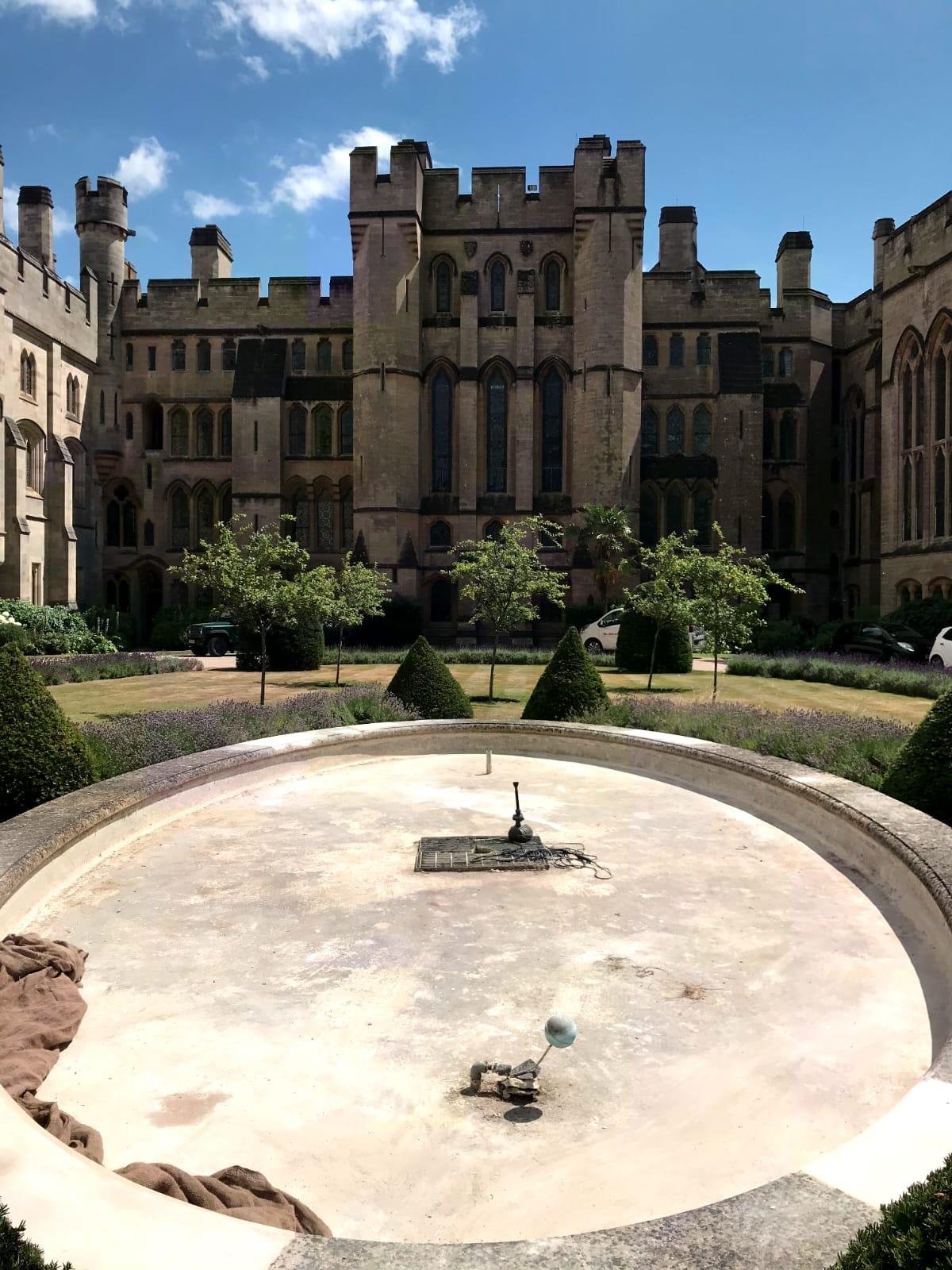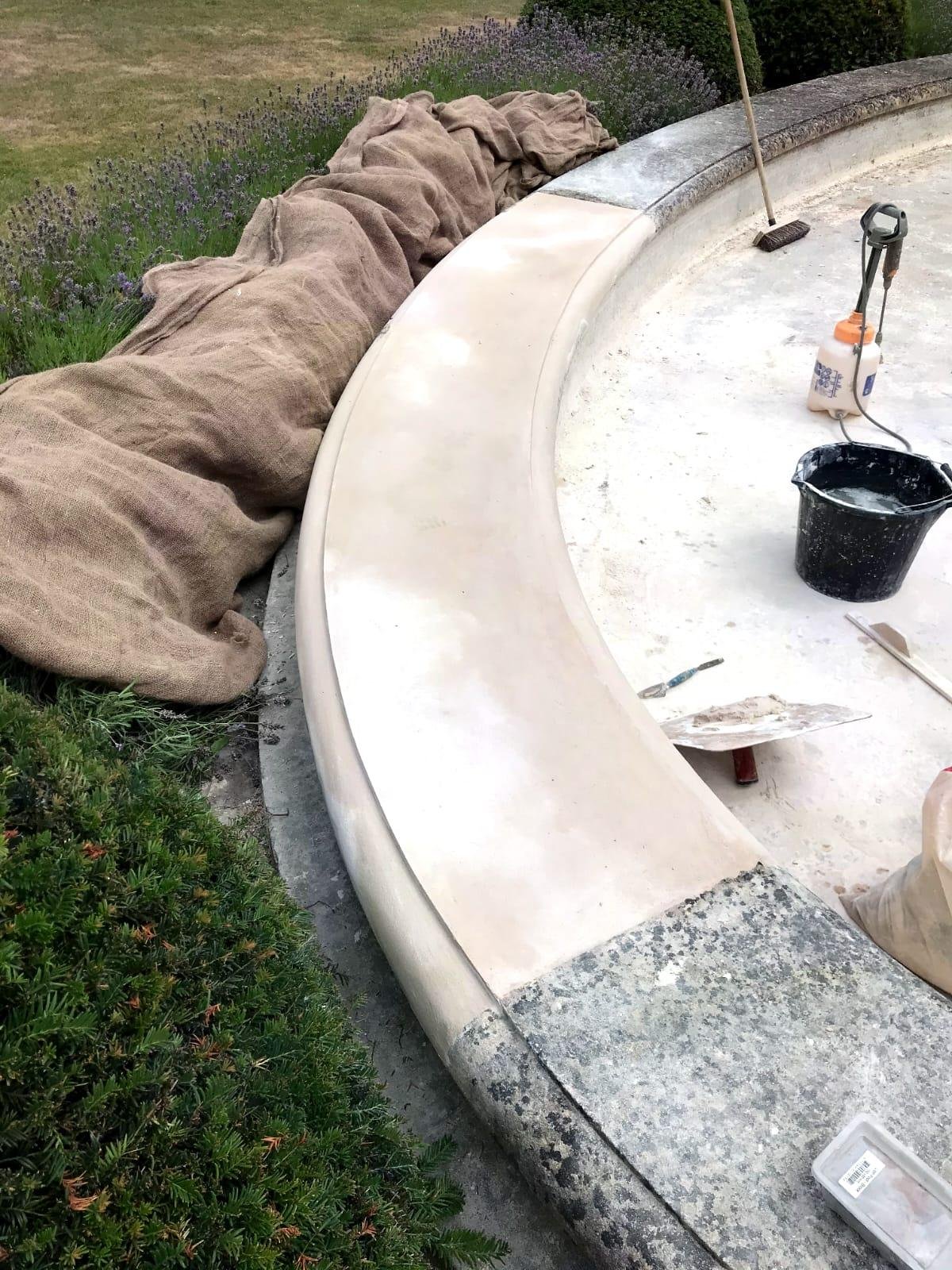
STONE COURT HOTEL, MAIDSTONE
In November 2020, we began work at ‘Stone court hotel’ in Maidstone. The property itself was undergoing a huge renovation by the current owner who is keen to preserve and restore the building back to its original beauty.
The building itself dates back to the 17th century and is listed as grade ll*. It boasts 2 stunning Tudor fireplaces and has many of its original features throughout the house. However, over the last few years a leak in the roof caused an issue to the first floor Tudor fireplace. The wall had been built with mud alone, thus causing the 2 story wall to drop and some parts collapse; luckily no one was living there at the time.
Before our involvement in the dismantle and rebuild, welsh miners had visited the property and fitted acrow props to stop any further collapse.
When we started on the project, we began by carefully dismantling the internal wall from the second story and down. This was a slow process due to instability of the wall, at each stage we added props to ensure the building was supported and safe for us to begin work underneath. During the dismantle we found a number of interesting finds amongst the stone and mud; these included old pieces of glass and oyster shells, which we believe the previous builders of the wall would have eaten for lunch and then tossed amongst the stone wall during they’re build.
After 2 weeks of slowly taking down the wall, we were finally ready to begin the rebuild, this would be done using a mixture of traditional coarse sand and lime. We began by building the internal wall to the garderobe which was currently only supported by the props. Once completed we were ready to set out and begin the internal wall rebuild on the ground floor. This was rather a puzzle due to the previous collapse of the wall we were unable to replace each stone where it initially fell from. Instead we had to use our intuition and pick the best stone for the job. Some of the stonework had individual details, which were not replicated in other stones. We felt that these stones shouldn’t be hidden, so we ensured they had a place.
The English heritage archeologist mentioned he believed there was an arch on the ground floor, spanning from the downstairs fireplace to the newly build side wall. We constructed a timber frame for the arch and after the stonework for the arch was chosen, we fitted this into position. With a lot of weight to be held up by the arch the project was at a standstill for a few weeks while we allowed the mortar to cure. Once this had fully dried we were then able to continue the build up to the first floor.
With the base now fully cured we moved on up to the first floor. On this floor stood the 2nd Tudor fireplace, which one half had been dismantled and set aside. As we did on the ground floor, we gradually built the wall up and started to fit into position the fireplace surround.
Finally, we had got to the level where we could begin to refit and realign the stone mantle piece for the fireplace. This required some manpower with the extensive weight of the stone. With a number of able bodies and mechanical lifting we were able to manoeuvre the stone into place. Once in place the stone was propped and pointed and allowed to dry before the final layer of ragstone was fitted on top of it. After another few weeks of drying, we were eventually able to lay the last stone and complete a full repoint to the wall.
Although, the project did come with some head scratching moments. With advice from the structural engineer we were able to determine the best and most importantly, the safest way to dismantle to wall without any excess falling down or dislodging any other element of the building.
It has been an honour to work on such a prestigious project and one what will be a beautiful family home.
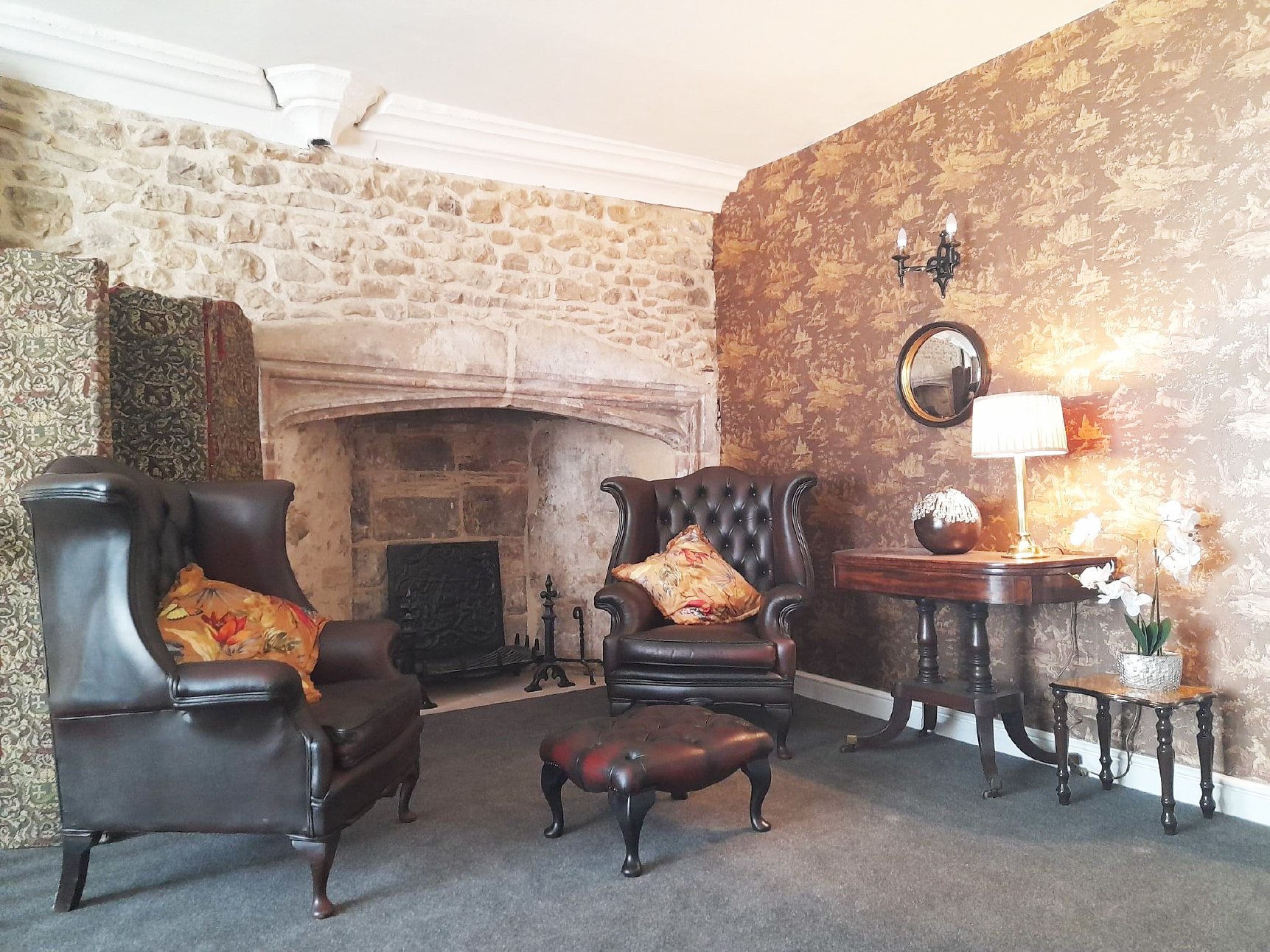
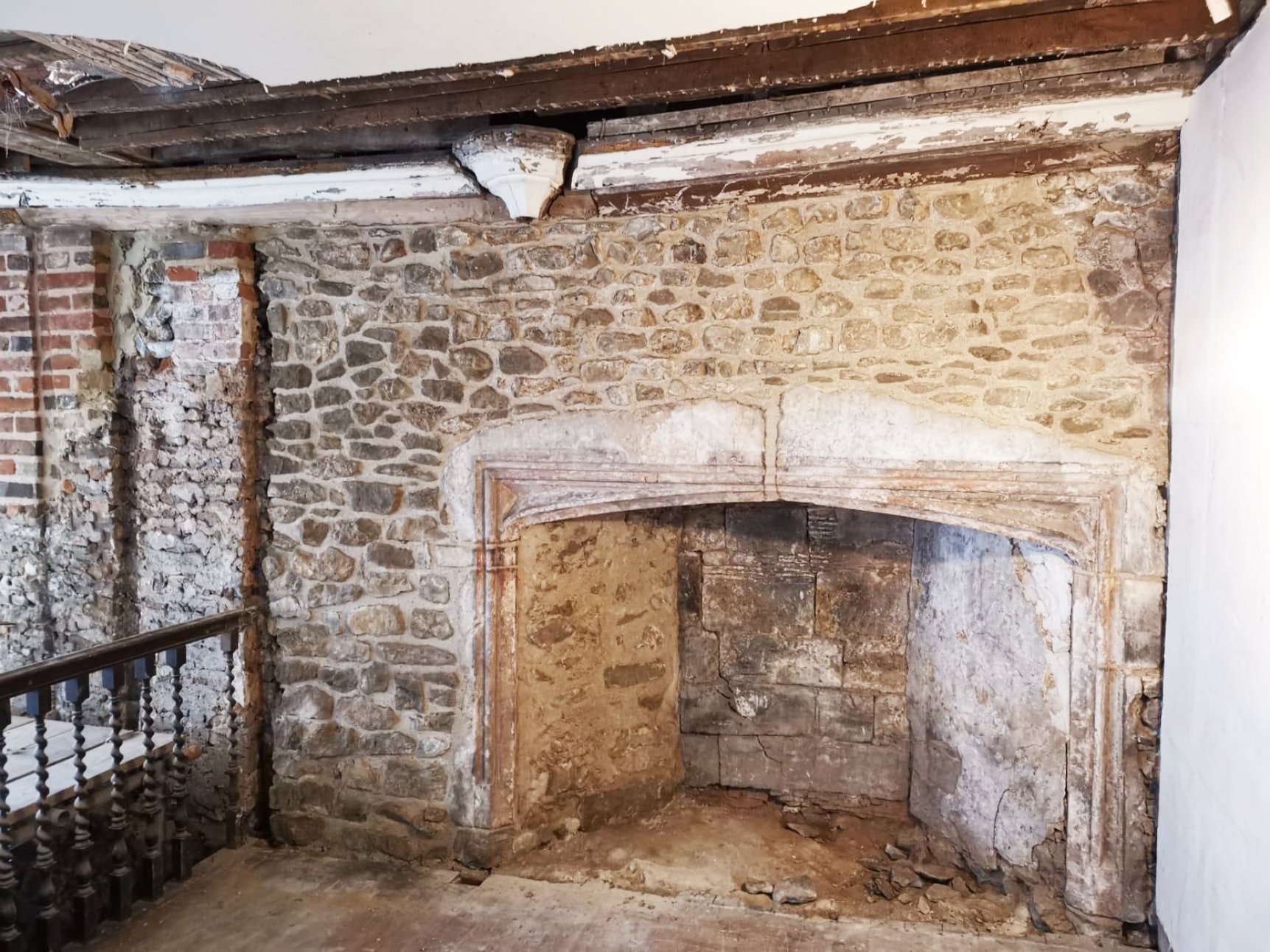

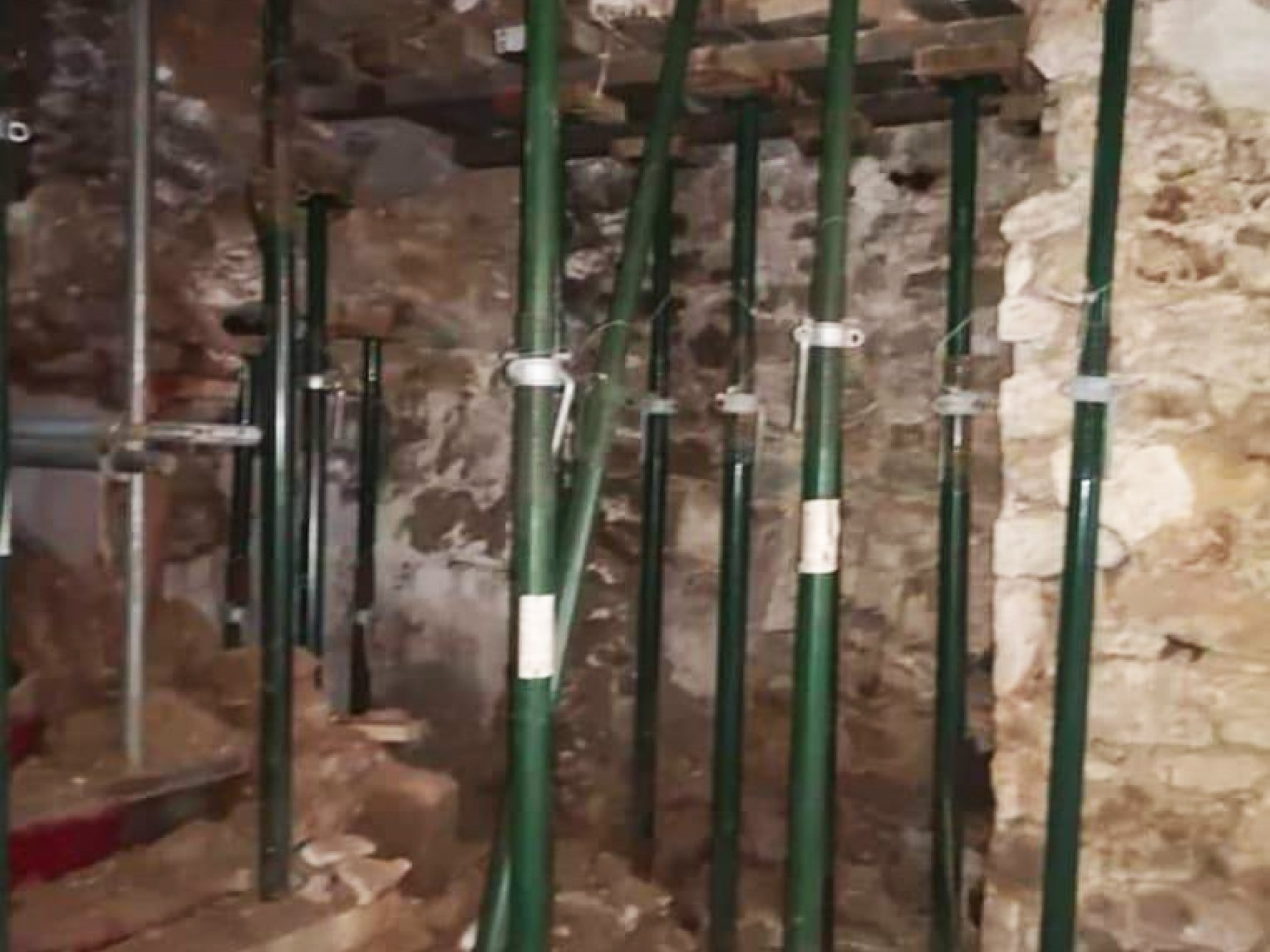

“Mark Axell Stone Restoration was contracted to carefully dismantle and rebuild our two-storey medieval wall with inserted Tudor fireplace at Stone Court House which had started to collapse after major water ingress after several years of neglect. Mark and his team of highly experienced stone masons were fantastic. They knew exactly what to do, were very professional, tidy, clean, and highly experienced when it comes to historic stone building restoration. We would highly recommend Mark Axell Stone Restoration, if you are looking for a quality finish, professional job at reasonable prices, then look no further, you have found the right team.”
Stone Court Hotel
The old vicarage, Grazeley
In October 2021, the team began work on an old vicarage located in Grazeley, Reading. The scope of work incorporated a full doff clean of the building and a full rake out and repoint. We were able to see that the previous mortar had been completed in a penny roll finish and both the client and I were passionate to continue this tradition and to reinstate this to the whole property. We had also identified that there were several stone replacements and re bedding of loose gable ridge stones and coping stones.
Being a heritage property we always attempt to match the texture and colour of the new pointing to the original pointing. This is achieved by combining a mixture of sands and carrying out mortar samples to get the best match.
Overall the project took 9 weeks to carry out. As you can see from the photos, the replacement of stones, full repoint and clean of the property has made a significant difference to the look of the property and has brought the old vicarage back to life.



Royal Hill, Blackheath
In 2021, the team carried out extensive repairs and restoration to a listed garden wall in Blackheath, London. The wall had been subject to extensive weathering, so a gentle doff clean and repoint was required, along with a number of brick replacements using reclaimed bricks.
Using traditional methods the defective remaining mortar was removed by hand, followed by matching mortar samples to ensure the original fabric was correctly matched. This was carried out by sampling a mixture of sand and lime to get the right coloured pointing.
Once the new pointing had cured, we applied a soot wash to the wall. This was achieved by using a mixture of natural earth pigments with water, it was then applied with a brush. The soot wash toned the new mortar down to match its surroundings.
“Mark Axell and his team recently completed a significant repair and repointing job on our 200+ year old garden wall in Greenwich.
Listed Grade II along with the house, the 60ft wall, running alongside the original ‘high’ street in Greenwich, had suffered decades of neglect. Water penetration had weakened the 6ft high structure, and led to leeching of salts which made the brick face and the mortar friable.
Mark and his father Dave have immense knowledge and experience of historic brick structures. They understand how deterioration happens and what needs to be done to mitigate it; they know how best to repair a wall and make it more resilient to weather for the future, while maintaining its distinct character.
Confident in their craftsmanship, we were not disappointed. They took great trouble to source exactly the right material. The careful raking out, repair and repointing with specialist lime mortar is slow and painstaking work, but we are delighted with the result – including the careful ‘soot washing’ to ensure the mortar colour is not too bright! They couldn’t be more willing and reliable.”
David Quarmby & Mary Sutherland - Greenwich SE10
College Park Baptist Chapel
In the summer of 2021, we were appointed to carry out a large stone replacement to the coping stones at College Park Baptist Church in Lewisham, London. This included the replacement of all the stepped copings, kneelers and the gable ridge stone. The previous stonework had been covered in layers of cement which had started to crack and become loose. With the stonework being over a main entrance, it was important to ensure safety of the public was a priority.
Prior to the work commencing, a sample of the existing stone was taken and sent to our stone supplier to ensure the new stone would match the original fabric of the building.
The team carefully dismantled and removed all the stonework to the building and removed this from site. In taking these stones down, we discovered a slight lean on the brickwork to the apex, which we consequently dismantled and rebuilt ready for the fitting of the new stones.
The project ran for 2-3 weeks and we successfully replaced the ancaster stone which matched into the church perfectly.
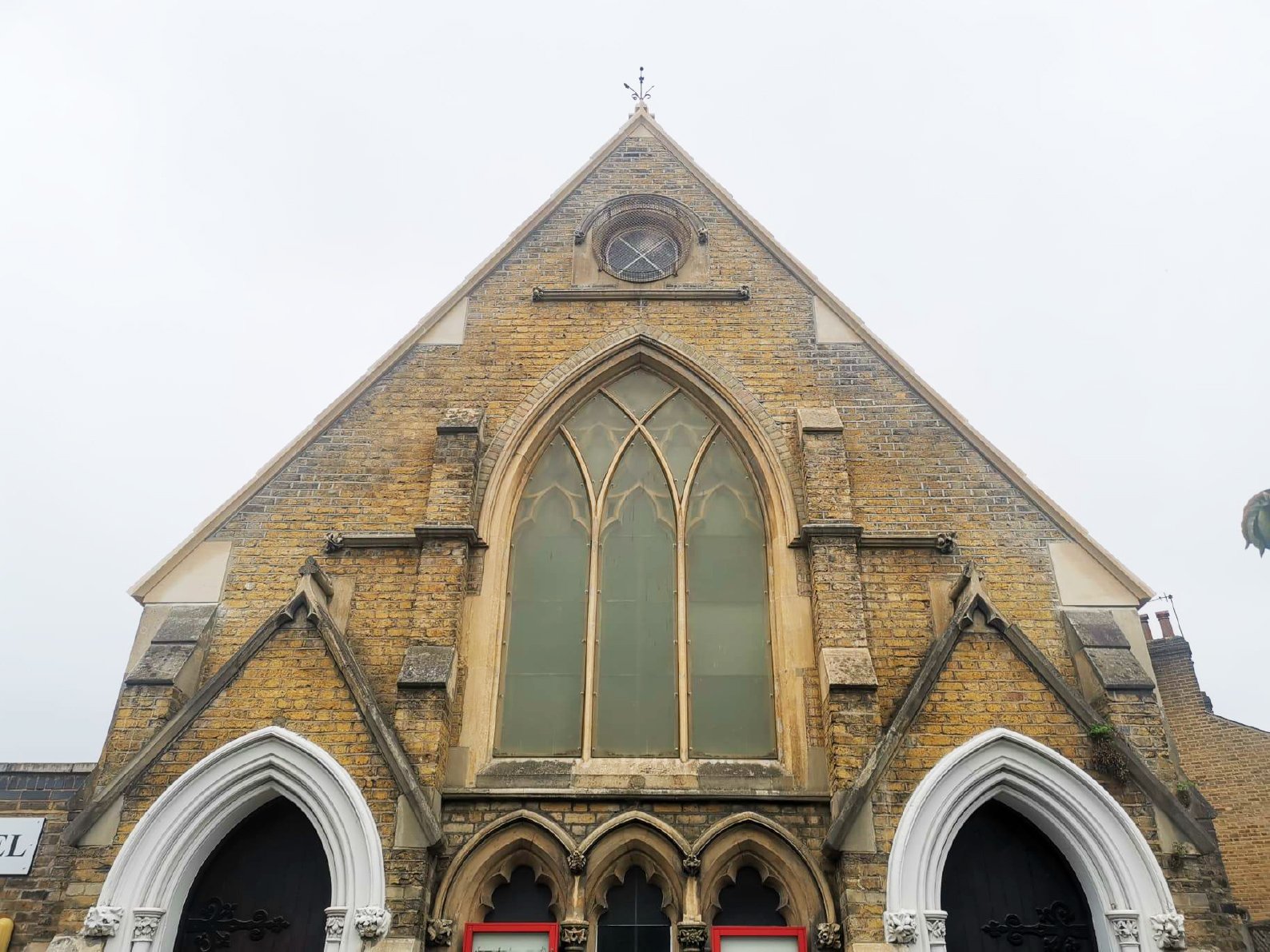
College of Arms, St. Pauls
In 2019, we were instructed by the main contractor to carry out repointing work to the front facade of the building for the tuck pointing alone. We spent 4-5 weeks working on the project without any challenges and the work was delivered to plan.
We carried out the tuck pointing using traditional methods and materials. This included making the size from scratch and colour matching the stopping with natural pigments to
ensure the existing brickwork matched with the new bricks that had been fitted. This required experience from the team to measure out the correct mix of sand and pigment to achieve the desired blend of colour. Being a grade 1 listed building we had to ensure the historic fabric of the building was matched correctly.
The team and I thoroughly enjoyed working on this project, it brings us pleasure that we got to work on such a prestigious building and our work will be on show for hundreds of years.
Cobbs Hall, East Malling
In March 2022, we began work on a grade ll listed property in East Malling, Kent. The property had previously been repointed incorrectly in cement mortar, in addition to there being various other issues that needed to be dealt with.
Our team carefully removed all the cement mortar to the 3 facades on the property, ensuring that the arises of the bricks did not get damaged during the task. We then removed any defective bricks and replaced them with bricks from a local reclamation yard to ensure it was a true match.
We always strive to match the new pointing colour to the colour of the original materials. To make sure the colour was correct, a number of samples were carried out using a mixture of sand and lime putty. When we had achieved the desired colour and coarseness of the new mortar, we were then ready to begin the pointing.
All the materials are gauged on site and mixed by ourselves, using traditional hand tools the new mortar was applied and beaten back to a flush finish. While carrying out the repointing we discovered a badly rotten beam, so we sourced, supplied and fitted a new reclaimed section.

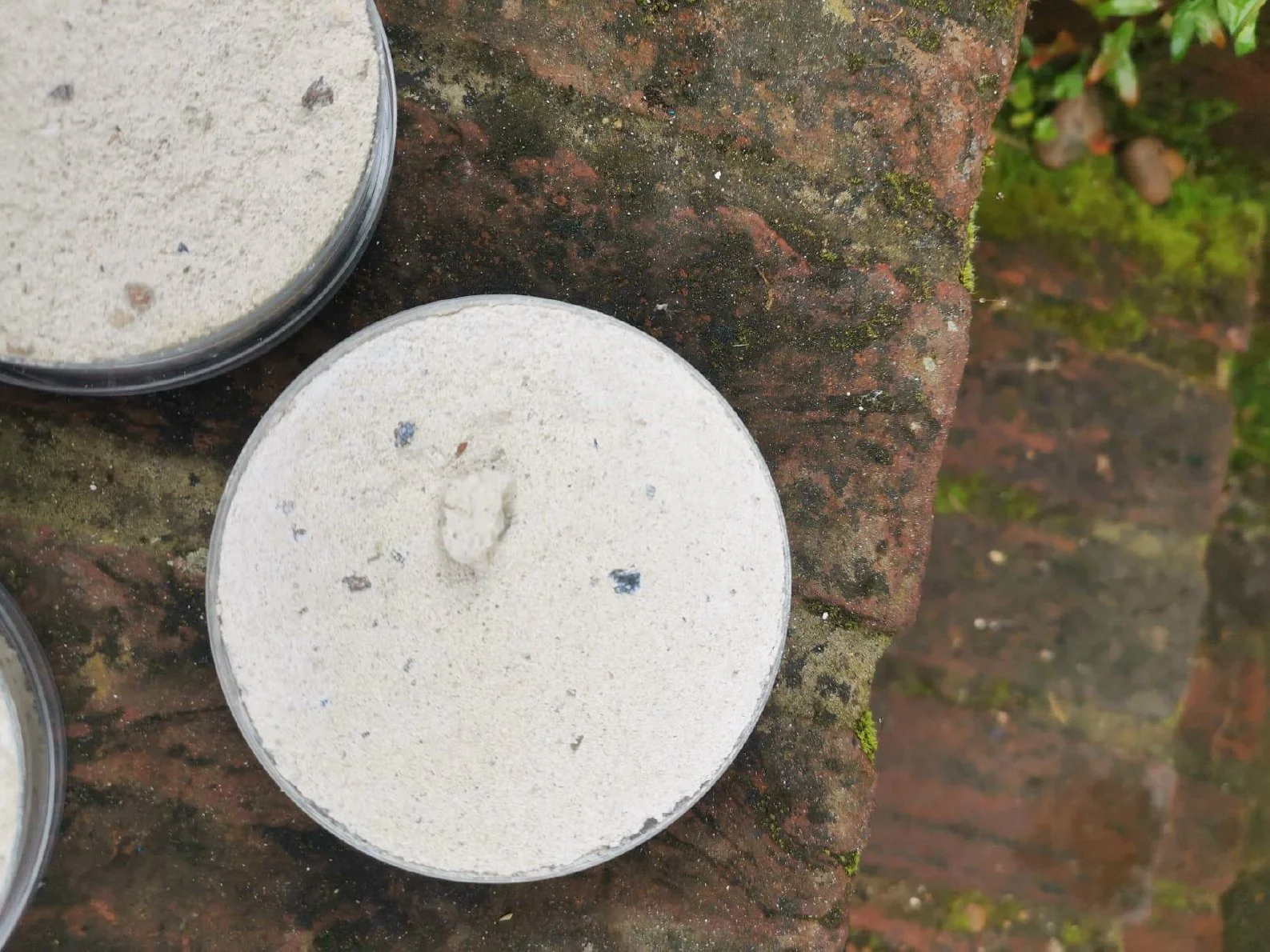
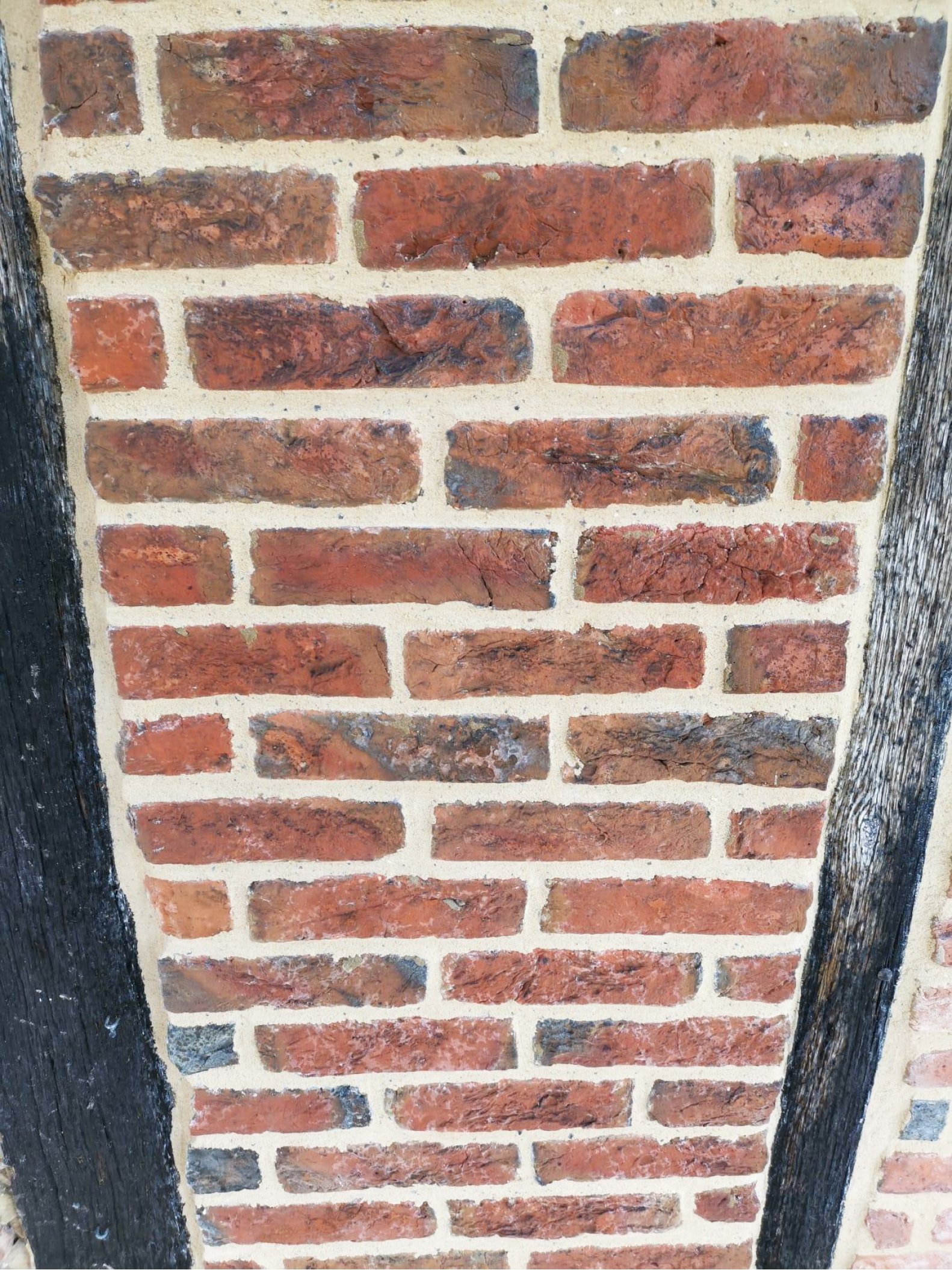
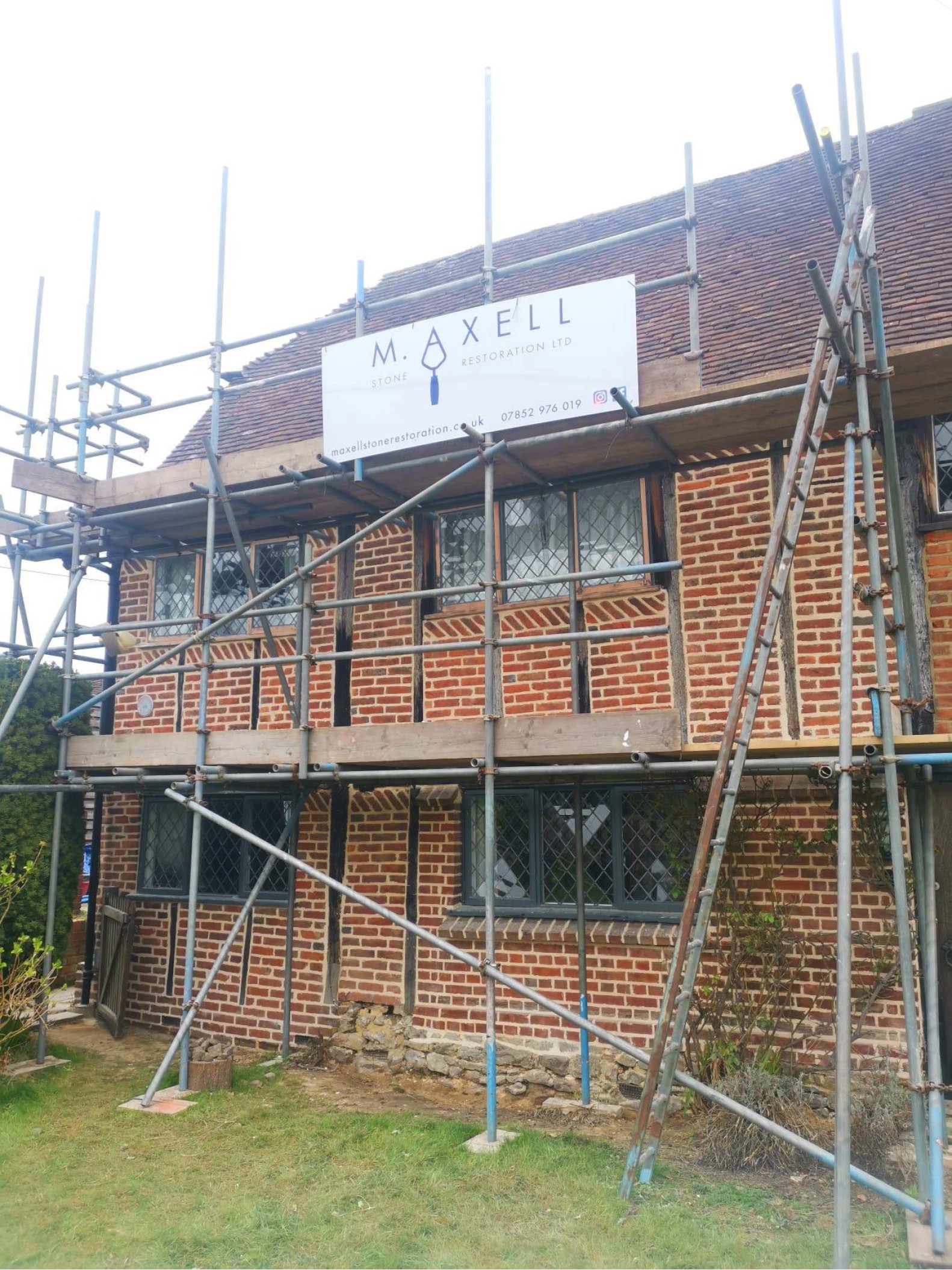
“When I contacted Mark and his team at M.Axell Stone Restoration Ltd to quote for repair and repoint of our grade II listed building brickwork, it was in a bad state, having been repointed with the incorrect cement mortar by previous owners for years, which was allowing rainwater and damp to damage the oak timbers. After a consultation with Mark, he advised me of the correct lime mortar to use, prepared a test patch to show how final colours would look and helped with providing method statements for listed building consent applications. When it came time to carry out the work Mark and his team arranged scaffold and were sensitive to our old building as they removed old cement. They then carried out all the repointing and brick repair to a high professional standard. The results and appearance of the final lime repointing on all elevations including chimney stack is borne out by positive comments from other professionals, friends and neighbours. Mark’s team of stonemasons were always friendly and professional on site, were complimented on their politeness by other trades working at our home and tidied away after each day. I would recommend M.Axell Stone Restoration Ltd to anybody with a listed property requiring sensitive and professional stonemasons.”
Philip Bell, Cobbs Hall Cottage
ARUNDEL CASTLE
In 2020, we were appointed by the maintenance team at Arundel castle to carry out stone repairs to the quadrangle fountain in the residence area of the castle. Previous cementus repairs had been carried out but had failed. Therefore, the failed sections required removal and new repairs to the stone using lime mortar.
We began by removing the previous repairs and keying up the original stonework in preparation for us to repair the stone. This was a slow process because the repairs needed to be deep and built out carefully ready for the shaping and floating. When the lime started to dry, we were able to shape the repairs to the original profile of the stone. This was achieved by hand.
